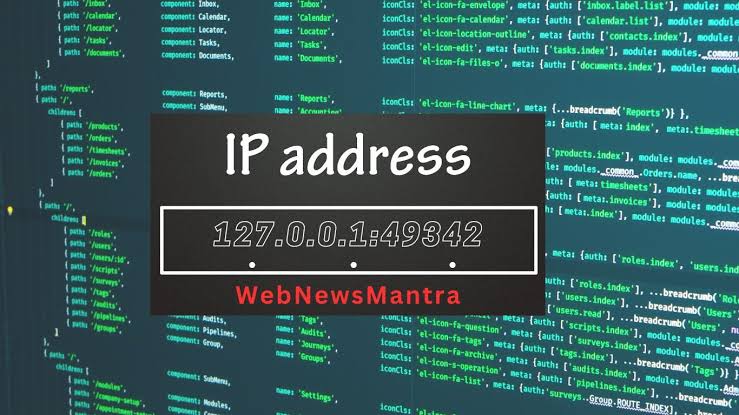What is 127.0.0.1?
127.0.0.1 is the loopback Internet Protocol (IP) address also referred to as localhost. This address is used by a computer to point back to itself. It is a default address that can be used to establish an IP connection to the same machine or computer being used by the end-user.
The Significance of Port 49342
In computer networking, a port is a communication endpoint. When dealing with IP addresses and network connections, ports are used to distinguish different types of network traffic. Port 49342 is a high-numbered port (also known as an ephemeral port) which is generally used for short-lived communications required by client applications to communicate with server applications.
How 127.0.0.1:49342 is Utilized
The combination of 127.0.0.1 and port 49342 can be used for various purposes in networking and software development. For instance:
Local Development and Testing: Developers often use the localhost IP address along with various ports to test applications on their local machines before deploying them to live environments. By assigning different ports, multiple applications can run simultaneously without conflict.
Network Diagnostics: Tools such as ping and traceroute use the localhost address to test network configurations and troubleshoot connectivity issues.
Security and Isolation: Running services on localhost with specific ports can help in isolating applications for security purposes. This way, services can be tested without exposing them to external networks.
Setting Up a Local Server on 127.0.0.1:49342
Choosing the Right Software: Depending on the application being developed, software like Apache, Nginx, or Node.js can be used to set up a local server.
Configuration: Configure the server to listen on port 49342. This involves editing configuration files to specify the IP address and port.
Running the Server: Start the server and test the connection by navigating to http://127.0.0.1:49342 in a web browser. If configured correctly, the server should respond to requests made to this address.
Practical Applications
Web Development: Local servers allow developers to build and test web applications in a controlled environment. This ensures that bugs and issues are resolved before the application goes live.
API Testing: Developers can use localhost with different ports to run and test APIs independently. This is crucial for microservices architecture where multiple services interact with each other.
Education and Learning: Setting up local servers is a fundamental skill for those learning networking and web development. It helps learners understand how web technologies work behind the scenes.
Common Issues and Troubleshooting
Port Conflicts: Sometimes, a port might be occupied by another service. Tools like netstat or lsof can help identify which service is using a particular port.
Firewall Restrictions: Firewalls might block access to certain ports. Configuring the firewall to allow traffic on port 49342 is necessary for the server to function correctly.
Misconfigurations: Errors in configuration files can prevent the server from starting. Checking logs and error messages can help diagnose these issues.
127.0.0.1:49342 represents a specific use of the localhost IP address combined with a high-numbered port, commonly utilized in development and testing scenarios. Understanding how to set up and troubleshoot local servers using this configuration is essential for developers and IT professionals to ensure smooth and secure application deployment.
FAQs
Q1: Why use 127.0.0.1 instead of other IP addresses?
A: 127.0.0.1 is specifically designed for loopback testing, meaning it directs the signal back to the same device. This is ideal for testing and development as it does not involve external networks.
Q2: Can I use any port number with 127.0.0.1?
A: Yes, but it’s important to choose ports that are not already in use by other applications to avoid conflicts.
Q3: How do I check if port 49342 is already in use?
A: On Unix-like systems, you can use the command lsof -i :49342 or netstat -an | grep 49342 to check if the port is in use. On Windows, netstat -an | findstr 49342 can be used.
Q4: What are ephemeral ports?
A: Ephemeral ports are temporary ports typically used for short-lived communications required by client applications to communicate with server applications. They are generally assigned dynamically.
Q5: Is it safe to expose 127.0.0.1:49342 to the internet?
A: No, localhost is intended for local use only. Exposing it to the internet can lead to security vulnerabilities.
Advanced Uses of 127.0.0.1:49342
Local Microservices Development
In modern software development, microservices architecture has become prevalent. Each microservice typically runs as a separate process, often on the same machine during development. By using different ports like 49342, developers can run multiple microservices simultaneously. This setup allows each microservice to communicate with others via predefined endpoints, simulating a production environment.
Example Setup
Imagine a simple microservices setup for an e-commerce application:
User Service: Runs on 127.0.0.1:4000
Product Service: Runs on 127.0.0.1:5000
Order Service: Runs on 127.0.0.1:49342
Each service is independently developed and tested, using the loopback address to ensure they can interact locally without external network dependencies.
Configuring Microservices
User Service Configuration:
json
Copy code
{
“host”: “127.0.0.1”,
“port”: 4000,
“database”: “users_db”
}
Product Service Configuration:
json
Copy code
{
“host”: “127.0.0.1”,
“port”: 5000,
“database”: “products_db”
}
Order Service Configuration:
json
Copy code
{
“host”: “127.0.0.1”,
“port”: 49342,
“database”: “orders_db”
}
Each service can be started independently and will listen on its assigned port, allowing for isolated development and testing.
Performance Testing
Using 127.0.0.1 with specific ports can also be beneficial for performance testing. Tools like Apache JMeter or Gatling can simulate multiple requests to a local server running on 127.0.0.1:49342, providing insights into how the application performs under load.
Setting Up Performance Tests
Install JMeter: Download and install Apache JMeter.
Create a Test Plan: Define a test plan that targets the local server.
xml
Copy code
<TestPlan>
<ThreadGroup>
<HTTPSamplerProxy>
<stringProp name=”HTTPSampler.domain”>127.0.0.1</stringProp>
<stringProp name=”HTTPSampler.port”>49342</stringProp>
<stringProp name=”HTTPSampler.path”>/api/orders</stringProp>
</HTTPSamplerProxy>
</ThreadGroup>
</TestPlan>
Run the Test: Execute the test plan and analyze the results to identify bottlenecks and optimize the application’s performance.
Security Considerations
While using 127.0.0.1 provides a secure environment for local development, it’s crucial to consider security best practices:
Limit Exposure: Ensure services running on localhost are not exposed to the external network unless necessary.
Use Firewalls: Configure firewalls to block unauthorized access to local ports.
Secure Development Practices: Follow secure coding practices to prevent vulnerabilities that could be exploited even in a local environment.
Common Issues and Solutions
Service Unavailable on 127.0.0.1:49342:
Cause: The server might not be running, or there could be a configuration error.
Solution: Ensure the server is started correctly and check configuration files for any errors.
Port Already in Use:
Cause: Another application might be using port 49342.
Solution: Identify the conflicting application using lsof or netstat and choose a different port if necessary.
Connection Refused:
Cause: Firewall or security software might be blocking the connection.
Solution: Configure the firewall to allow traffic on port 49342 or temporarily disable security software for testing.
Advanced Configuration Tips
Environment Variables: Use environment variables to manage IP addresses and ports. This makes it easy to change configurations without modifying code.
bash
Copy code
export SERVICE_PORT=49342
Docker Containers: Run services in Docker containers to encapsulate the environment. This ensures consistency across different development machines.
yaml
Copy code
version: ‘3’
services:
orders:
image: orders-service
ports:
– “49342:49342”
environment:
– SERVICE_PORT=49342
Conclusion
Using 127.0.0.1:49342 is a powerful technique for local development, testing, and troubleshooting. It allows developers to create a controlled environment, ensuring that applications run smoothly before being deployed to production. By understanding how to effectively use localhost and specific ports, developers can enhance their workflow, improve security, and ensure high-quality software delivery.
FAQs
Q1: How can I automate the setup of local servers on different ports?
A: Tools like Docker Compose or Kubernetes can automate the deployment and management of local servers, making it easier to handle multiple services.
Q2: Is it possible to run multiple instances of the same service on different ports?
A: Yes, by configuring each instance to listen on a unique port, multiple instances of the same service can run simultaneously.
Q3: How do I secure my local development environment?
A: Use strong firewall rules, avoid exposing unnecessary ports, and follow best practices for secure coding and configuration management.
Q4: Can I use localhost for production environments?
A: No, localhost is intended for development and testing purposes only. Production environments should use proper IP addressing and network configurations.
Q5: What tools can help monitor local server performance?
A: Tools like Prometheus, Grafana, and New Relic can provide insights into server performance, even in local development environments.


